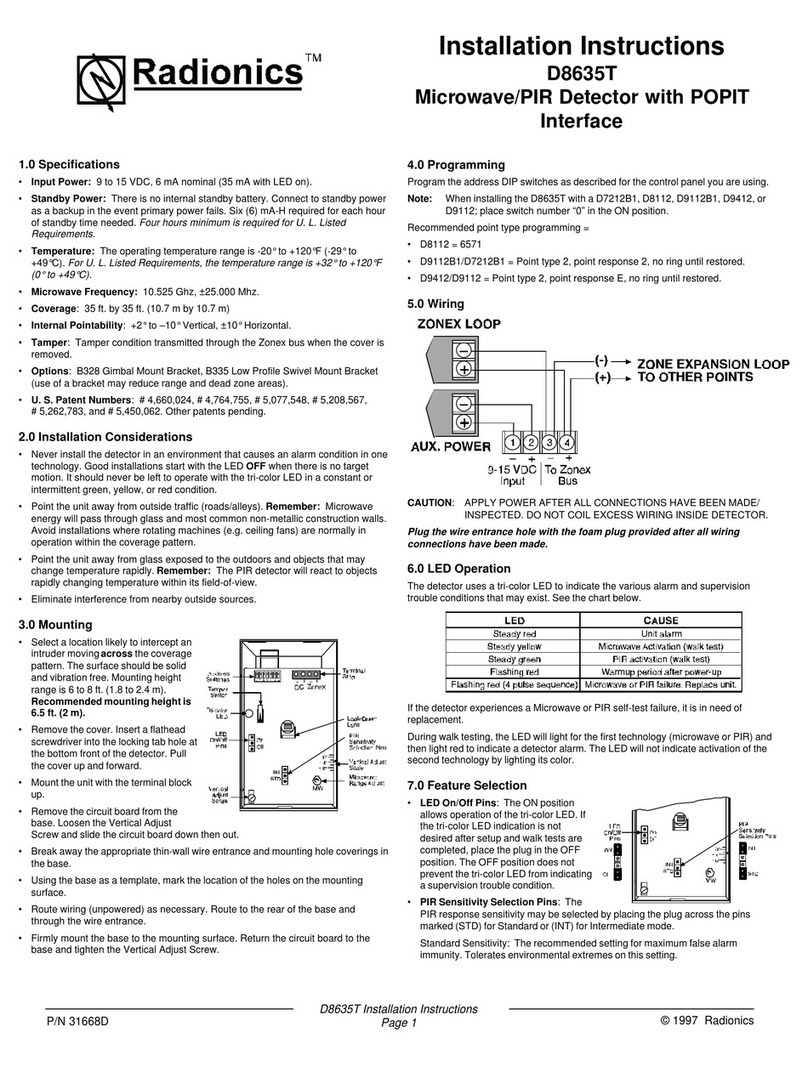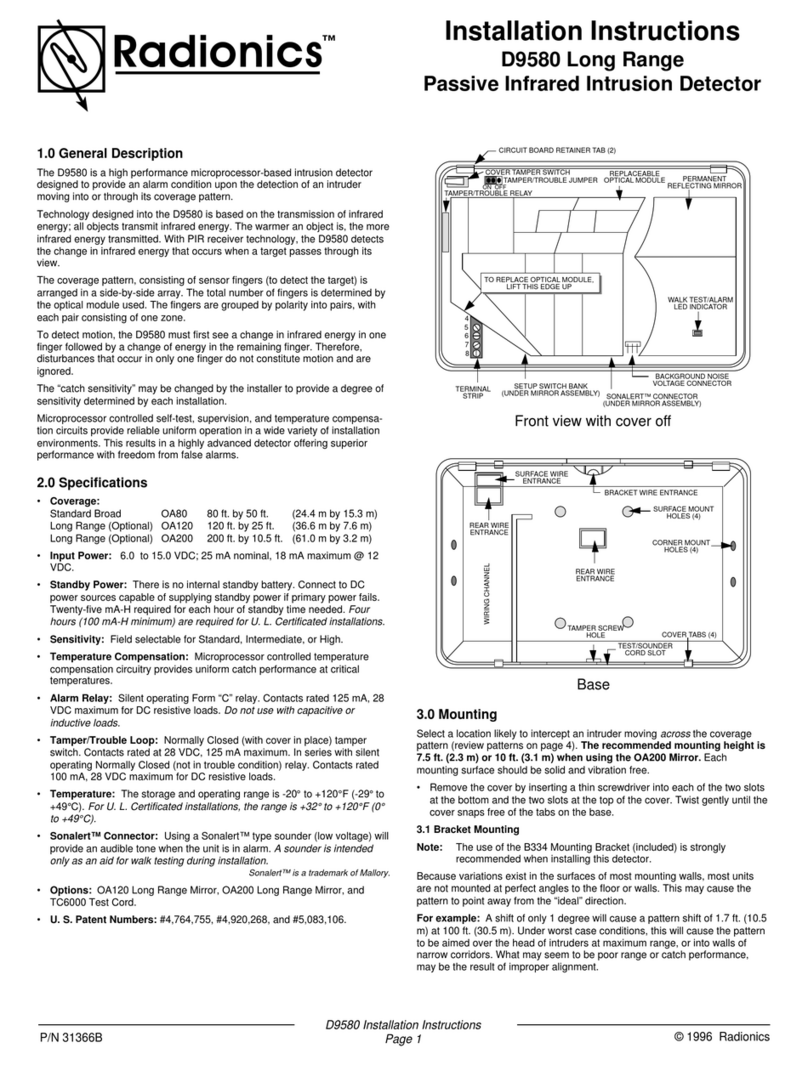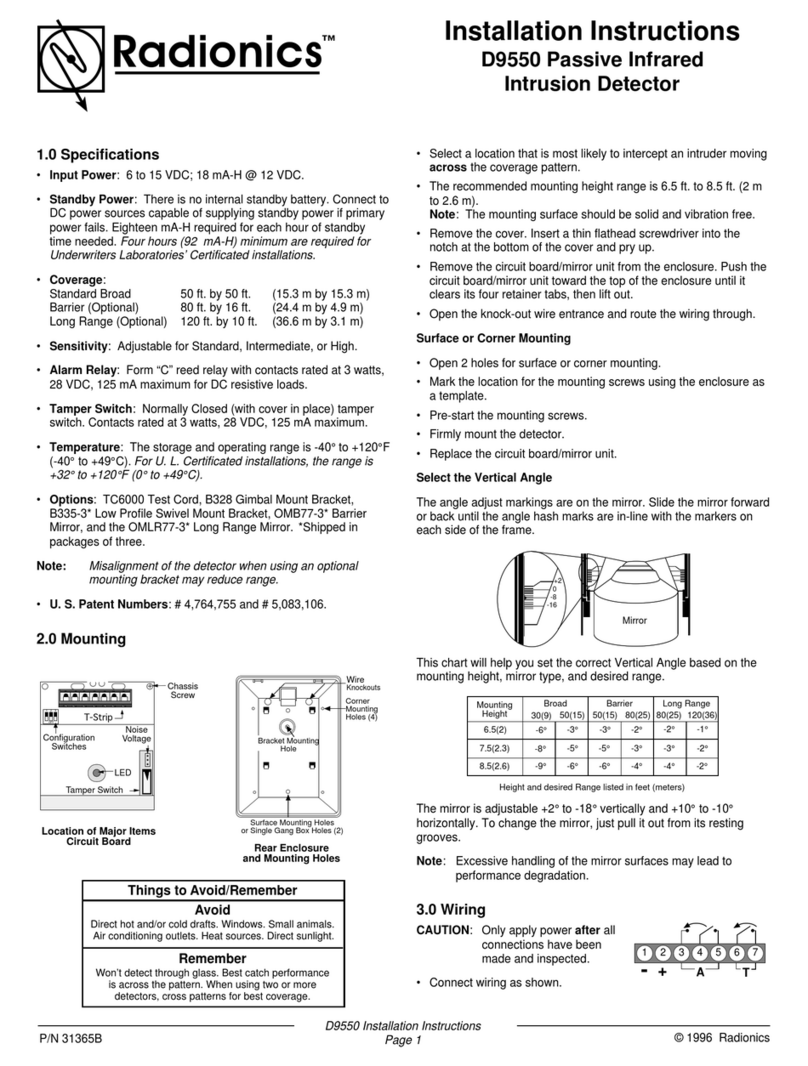
Radionics™
© 1996 Radionics, Inc., Salinas, CA, U.S.A. All rights reserved.
™ The Radionics logo is a registered trademark of Radionics, Inc., Salinas, CA, U.S.A.
Radionics, Inc., 1800 Abbott Street
Salinas, CA, 93901, U.S.A.
Customer Service: (800) 538-5807
7.0 Setup and Walk Tests
Select the vertical starting angle from the chart. To
adjust the vertical starting angle for the desired
mounting height and range, loosen the vertical adjust
screw and slide the board up to point the angle down.
Note the settings on the vertical adjust scale.
Note: The proper vertical angle must be selected for installations containing
pets. See Section 11.0.
• Place the LED plug in the ON position.
•Wait at least two minutes, after applying power, to start walk tests.
Note: During the warm-up period, the tri-color LED will flash red until the unit
has stabilized and has seen no movement for two seconds (approx. 1
to 2 minutes). When the LED stops flashing, the detector is ready to
be tested. With no motion in the protection area, the LED should be
OFF. If the LED is on, re-check the protection area for disturbances
affecting the microwave (yellow) or PIR (green) technologies.
Establishing PIR Pattern Coverage
• Turn the Microwave range adjust to minimum and replace the cover.
• Walk test across the pattern at its farthest edge, then several times closer
to the detector. Start walking from outside of the intended protection area,
and observe the tri-color LED. The edge of the pattern is determined by the
first green, PIR activation of the LED (or the first red activation if the yellow
microwave LED activates first).
• Walk test from the opposite direction to determine both boundaries. The
center of the pattern should be pointed toward the center of the intended
protection area.
• Slowly bring your arm up and into the pattern to mark the lower boundary on
PIR alarm. Perform this task at 10 to 20 ft. (3.1 to 6.1 m) from the unit.
Repeat from above for the upper boundary. The center of the pattern
should not be tilted upward.
If desired coverage can not be achieved, try angling the coverage pattern up
or down to assure the pattern is not aimed too high or low. For pet
applications, do not adjust below recommended angle. The angle of the
PIR pattern may be vertically positioned between -10°and +2°by
loosening the Vertical Adjust screw and sliding the circuit board up or
down. Moving the board up will angle the pattern downward. Tighten
the screw snug when positioning is completed.
Note: The pattern may be moved ±10°horizontally by moving the
lens window left/right.
Establishing Microwave Coverage
Note: It is important to wait 1 minute after removing/replacing the cover so
the microwave portion of the detector can settle, and to wait at least
10 seconds between the following walk testing procedures.
• The tri-color LED should be OFF before walk testing.
• Walk test across the pattern at the intended coverage’s farthest end. Start
walking from outside the intended protection area and observe the tri-color
LED. The edge of the microwave pattern is determined by the first yellow,
microwave activation of the LED (or the first red activation if the green PIR
LED activates first).
• If adequate range can not be reached, increase the Microwave Range
Adjust slightly. Continue walk testing (waiting 1 minute after removing/
replacing the cover) and adjusting the range until the farthest edge of
desired coverage has been accurately placed.
Do not adjust the microwave range higher than required. Doing so will
enable the detector to catch movement outside of the intended
coverage pattern.
• Walk test the unit from all directions to determine all the detection pattern
boundaries.
Establishing Detector Coverage
• The tri-color LED should be OFF before walk testing.
• Walk test the unit from all directions to determine the detection boundaries.
A detector alarm is signaled by the first red activation of the tri-color LED
after an initial green or yellow activation.
8.0 Supervision Features
The supervision features function as follows:
•PIR/Microwave: The complete circuit operation of these subsystems is
checked approximately every 12 hours. If the PIR or microwave subsystem
fails, the tri-color LED will flash red 4 times per cycle and the unit should be
replaced.
•Default: The detector will default to PIR technology protection if the
microwave subsystem fails. When defaulting to PIR, the PIR signal
processing will change from INT to STD sensitivity.
9.0 Other Information
Maintenance: At least once a year, the range and coverage should be
verified. To ensure continual daily operation, the end user should be instructed
to walk through the far end of the coverage pattern. This ensures an alarm
output prior to arming the system.
Pattern Masking: The PIR coverage pattern may be masked using masking
tape or electrical tape on the inside of the lens.
Note: Masking only eliminates the PIR portion of the coverage and has no
effect on the microwave pattern.
10.0 Coverage Pattern
The protected coverage area is where the microwave and PIR patterns
overlap.
An optional Look Down lens is located under the detector. This lens must be
unmasked before it is operational. The Look Down lens is not recommended
for installations containing pets or small animals. The Look Down finger is
shown in black below.
11.0 Special Instructions for Installations Containing Pets
The D8535 will provide reasonable protection from nuisance alarms caused by
the following sources:
• A dog up to 80 pounds (36 kg) • Up to 5 cats
• Multiple small rodents, such as rats • Random flying birds
To take full advantage of the D8535’s Signature Recognition Technology, the
following guidelines should be followed:
• Mount the detector 6-1/2 ft. (2 m) high and adjust the PIR angle
to -5°.
Note: The use of a mounting bracket is not
recommended for pet applications.
•Set the PIR sensitivity for Standard (STD).
• Mount where the animals can not come within 6 ft.
(1.8 m) of the detector by climbing on furniture, boxes or other
objects.
• Do not remove the Look Down lens
mask.
• Don’t aim the detector at stairways the
animals can climb on.
• Adjust the microwave range for the
minimum acceptable coverage for the
room in which the detector is installed.
OK MIN MAX
Note: Pet avoidance is only available when using the lens provided with the
detector.
This nuisance protection has not been verified by Underwriter’s Laboratories,
Inc.
6.5 ft. (2 m)
7.0 ft. (2.1 m)
8.0 ft. (2.4 m) -7°
-5°
-6°
Range
35 ft. (10.7 m)
D8535
Mounting
Height
6-1/2
feet
INT
STD
6
feet
Feet
Feet
0 5 10152025 3035
0
TOP VIEW
5
10
15
20
5
10
15
20 0
Meters1.6 3.2 4.8 6.4 8 9.6 11.2
Feet
10
0
Feet
0 5 10 15 20 25 30
-5°
SIDE VIEW
0
Meters 1.6 3.2 4.8 6.4 8 9.6
35
11
Remove masking for Look Down zone. Do not remove for pet applications.
ABC
D
E
F
G
H
I
J
K
A-K
L-OP-ST-WX
L
M
N
O
P
Q
R
S
TU
V
W
X






















